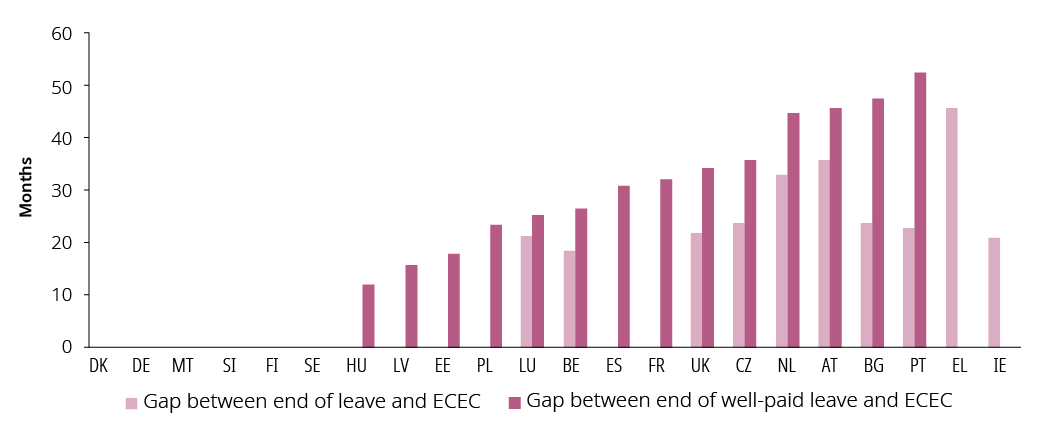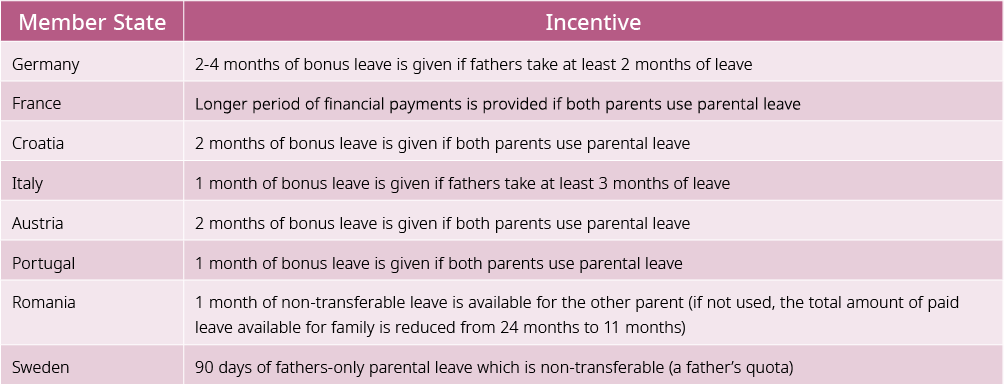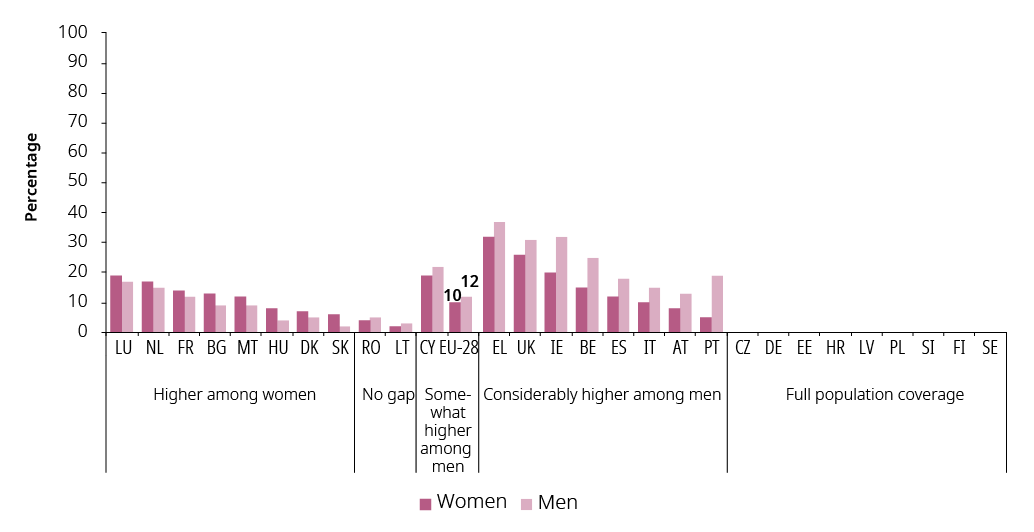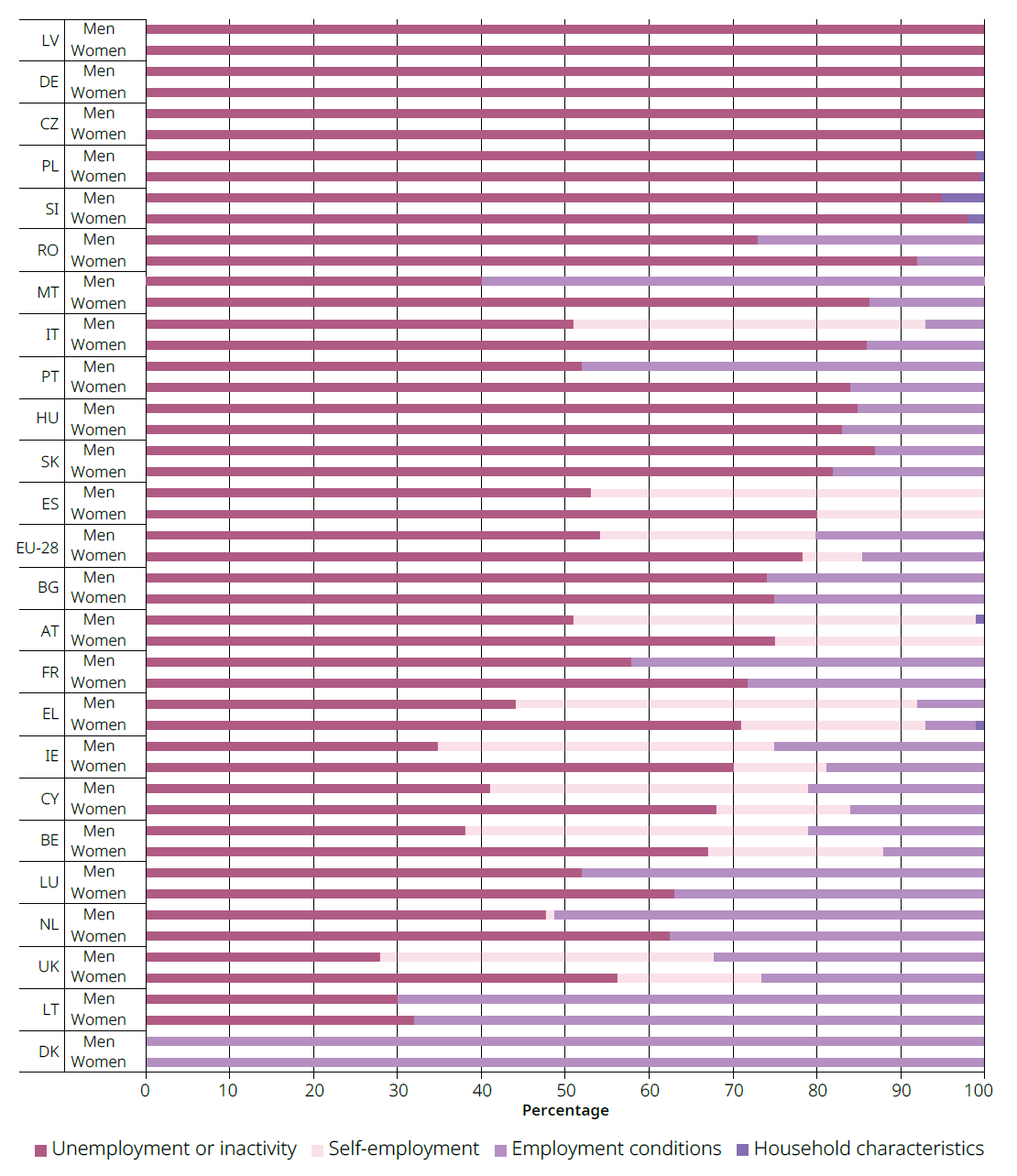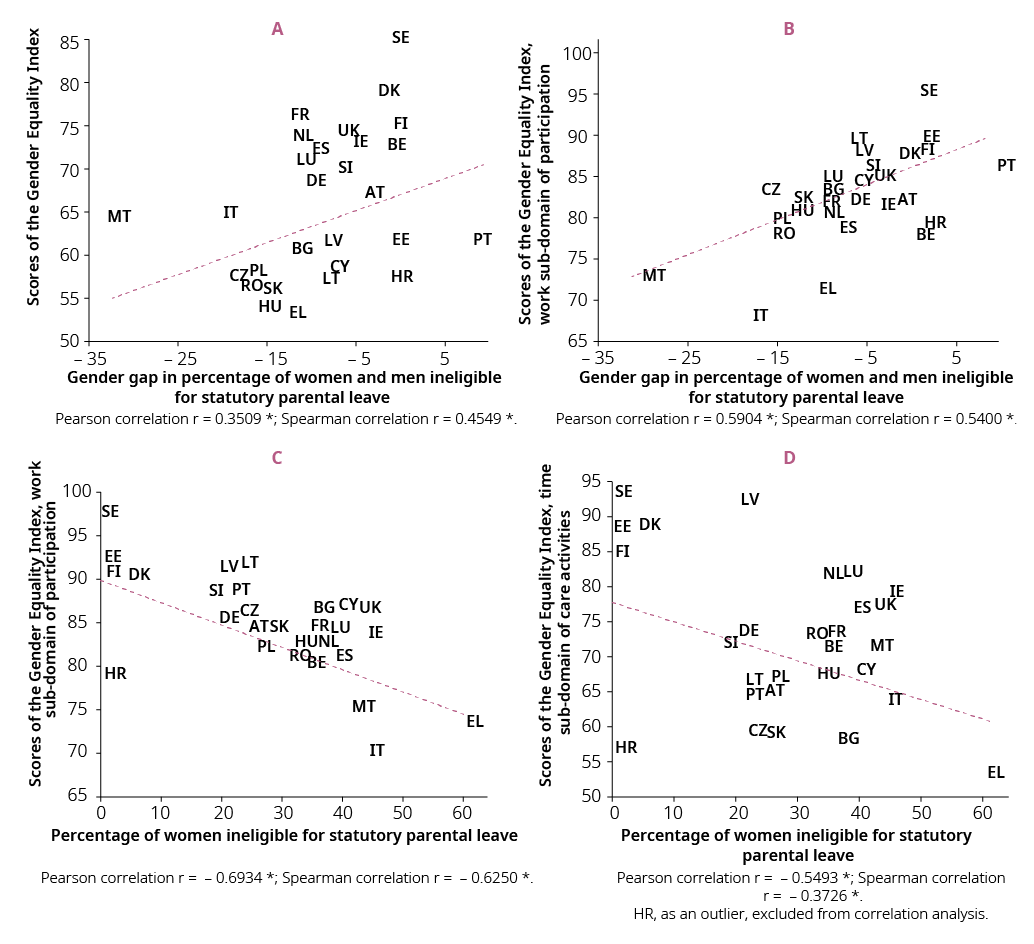Parental-leave policies
Parental-leave conditions may help or hinder gender equality
The increase in female employment rates, coupled with the decline of the male breadwinner family model, have unsettled traditional gender work roles and expectations (Connolly, Aldrich, O’Brien, Speight, & Poole, 2016; Trask, 2010). In this context, entitlements to job-protected leave after childbirth have become important policy measures to support parents (ILO, 2014). They provide time-limited job protection to enable an employee to care for their new-born child, and afterwards return to work with the same employer, usually to the same job. These leave policies not only support gender equality, they are also important policy instruments for supporting child, maternal and paternal health and well-being, birth rates and various labour-market outcomes, such as increased women’s participation in the labour market and reduced gender pay gaps (Andersen, 2018; Kamerman & Moss, 2009). Similarly, leave policies can be seen as important tools to fulfil children’s rights to have time with and care from from both their parents (Haas & Hwang, 1999).
Working parents across Member States are entitled to a range of types of leave, the most common being maternity leave, paternity leave, parental leave and leave to care for children who are ill (Blum, Koslowski, Macht, & Moss, 2018). Maternity leave is mostly understood as a health-and-welfare measure intended to protect the health of both the mother and the new-born child. Paternity leave is usually short leave taken after the birth or adoption of a child and intended to enable the father/co-parent to spend time with the partner and new child.
This analysis focuses on parental leave, which is generally understood to be a care measure intended to give both parents an equal opportunity to spend time caring for a young child. Usually, it can only be taken at the end of maternity leave (Blum et al., 2018). Some Member States aim for an almost gender-neutral leave policy (e.g. SE), with most of the available leave designated as parental leave. Other Member States have leave-system designs that identify a mother as a primary carer, with emphasis on a long period of maternity leave before the parental leave.
Regular monitoring of parental leave policies by the International Network on Leave Policies and Research[1] shows that leave policies in the EU are in constant flux (Blum et al., 2018). Member States are working on leave-policy designs that not only support better gender balance in the use of parental leave and the work—life balance of all working parents, but also enhance fertility rates and child well-being.
A growing body of research is trying to identify how different leave-policy characteristics work towards varied and often conflicting policy purposes. The most crucial components of leave policies are the length of leave, payment levels, flexibility, financing, eligibility rules and coordination with childcare services. These all impact the behaviour of women and men taking leave and their participation in the labour market, with consequences for gender equality.
Some characteristics are positively associated with gender equality, such as an individual entitlement for fathers. Others, including extended leave for mothers, have negative associations. For gender-equality objectives, supporting the employment of mothers and increasing the take-up of leave by fathers are of particular interest. Although reliable comparable data is scarce, the overall take-up of parental leave by men is generally estimated to be very low (Blum et al., 2018; Karu & Tremblay, 2018).
Childcare services are not available when childcare leave ends
Among EU Member States, the types of childcare leave and parental leave specifically offered to young parents vary enormously. Although all Member States fulfil the minimum 4-month requirement set out in the parental leave directive (Directive 2010/18/EU), the overall duration of available leave differs considerably across the EU (see Annex 5). There are Member States where the parental leave is less barely exceeds the 4-month requirement such as the United Kingdom with 4.2 months and Poland with 7.4 months. Other Member States provide leave until the child is 3 years old (e.g. CZ, EE, ES, FR, LT, HU) (Blum et al., 2018).
Parental leave is only one type of leave available to parents. Counting all available maternity, paternity and parental leaves, both paid and/or unpaid, the parents may have job-protected absence from work available lasting 3 years or even more (e.g. DE, EE, FR, HR, LT, PL, PT, FI). In several Member States over 9 months of childcare leave are well paid, i.e. at least 66 % of previous monthly pay (e.g. BG, CZ, DK, EE, DE, HU, LT, AT, PL, RO, SI, FI, SE), while in other Member States less than 4 months is granted (e.g. BE, IE, FR, IT, LV, MT, NL, UK) (Blum et al., 2018).
Although a generous parental-leave entitlement could be seen as beneficial from a child well-being point of view, there is no agreement on the optimal duration of parental leave. Arguments can be found supporting shorter leave to avoid the negative impacts on women’s working life and employment and the gender imbalance in the workplace that long career breaks have. Both types of leave (very short or very long duration) are associated with reduced female labour-market participation (Akgunduz & Plantenga, 2012; Genre, Salvador, & Lamo, 2010; Misra, Budig, & Boeckmann, 2011; Olivetti & Petrongolo, 2017; Pettit & Hook, 2005).
Parental-leave duration and its impact strongly depends on other leave characteristics and on the availability of care services. Good-quality and affordable (public) childcare services need to be available at the end of parental leave to allow parents to return to work. In most EU Member States (except HR, IT, LT, RO and SK), parents are entitled to early childhood education and care (ECEC) services through a statutory obligation for authorities to provide a care or nursery place for a child should a parent so wish. A lack of gaps between the end of leave provision and the start of subsidised, high-quality ECEC is linked to greater women’s participation in the labour market (OECD, 2018b).
As of April 2018, 12 Member States (DK, DE, EE, ES, FR, LV, HU, MT, PL, SI, FI, SE) had no gaps between the end of leave and the start of ECEC entitlements (Figure 34). It is assumed that with the help of public childcare, the transition from leave back to employment is relatively smooth for parents in these Member States. However, evidence suggests that despite such entitlement, care services are not always easily available or sufficient, for example in Estonia, Germany and Hungary (Blum et al., 2018). Only in a few Member States (DK, DE, MT, SI, FI, SE) does publicly subsidised childcare begin as paid parental leave ends. The largest care gaps are found in Austria (36 months) and the Netherlands (33.2 months). This highlights a clear lack of coordination between the two policy areas (Blum et al., 2018).
Figure 34: Care gap: time between the end of (well-paid) leave and ECEC entitlement (in months)
Note: There is no entitlement for ECEC in HR, IT, LT, RO and SK. In IE, there is no well-paid leave. In EL, the gap displayed is for the private sector. In the public sector, there is no gap between the leave and ECEC, and the gap between well-paid leave and ECEC is 48 months. No information is available on Cyprus.
ECEC entitlement refers to the statutory obligation to provide a place for a child, should a parent wish to use it. Where there is no statutory entitlement there may still be both public and private provision available.
Well-paid leave: earnings-related payment at 66 % or above of earnings (not taking into account the possibility of a ceiling). All types of leave are counted (including maternity, paternity, parental and childcare/time credit, including any parental-leave bonus but excluding leave to care for sick children).
Take-up of parental leave by fathers remains a challenge
Parental leave can be either an individual non-transferable entitlement, an individual transferable entitlement or a family entitlement. The latter means that a family can decide who takes the leave. While parental leave secures job protection for those taking time off to care for their children, it does not protect against the negative impact of such breaks on career progression, pay and other aspects of working life. The negative impact of parenthood on women’s employment is largely due to their disproportionate take-up of care duties and career breaks.
If childcare is no longer considered the sole domain of women and more fathers take parental leave to stay at home and look after their children in their first year, the outcomes for gender equality include increased women’s labour-market participation, reduced gender pay gaps and increased men’s participation in household work (Andersen, 2018; O’Brien & Wall, 2017).
There are no reliable comparable statistics available on the uptake or share of parental leave by fathers in the EU. Scarce available information does, however, indicate that the lion’s share is taken up by women in all Member States. For instance, Poland reported 99 % of parental-leave takers to be women (Kurowska, Michoń, & Godlewska-Bujok, 2018), while in France 4.4 % of beneficiaries were men (Boyer & Fagnani, 2018), and in Croatia fathers accounted for around 4.5 % of all parental leave taken (Dobrotić, 2018). The take-up by men is changing slowly, even in Member States such as Sweden, where 45 % of the parental-leave benefit recipients were men. In total, men used only 27 % of all parental-leave days used during 2016 (Duvander & Haas, 2018). Danish fathers on average took 11.7 % of the parental-leave period in total in 2016 (Bloksgaard & Rostgaard, 2018).
Increased take-up of leave by fathers is strongly linked to access to individual entitlement (Duvander & Johansson, 2012; Haas & Rostgaard, 2011). However, there is no evidence that non-transferable leave is sufficient to lead to increased use of parental leave by the fathers, unless it is well paid (Karu & Tremblay, 2018).
A new directive on work—life balance for parents and carers in 2019 introduced for the first time at least 10 working days of paid paternity leave and proposed an additional incentive (paid non-transferable parental leave of 2 out of 4 months) to encourage greater take-up by fathers.
Another approach offers some form of bonus if both parents share parental leave. Several Member States offer specifically tailored incentives to get more fathers to use their leave (Table 5). For example, Sweden has a ‘gender equality bonus’ or a ‘father’s quota’ that allocates an additional 90 days of the leave to fathers. If the fathers do not use it, the family loses both the leave and the financial benefit associated with it. Austria, Croatia, Germany and Italy offer bonus time of varying amounts to families where the father shares part of the leave.
Although information on the actual take-up or effectiveness of such incentives is scarce, the number of fathers using a month of parental leave in Portugal increased significantly after the bonus was introduced in 2009: from 596 fathers in 2008 to more than 24 000 by 2017 (Wall & Leitão, 2018). The introduction of the father’s quota in Sweden also led to increased uptake, and 44 % of men had taken their reserved days for children born in 2013 by 2015 (Duvander & Haas, 2018).
The financial implications of parental leave are another factor determining its take-up by fathers, given that families are dependent on the higher salaries usually earned by men. Parental leave can either be paid at a certain percentage of previous taxable income, be paid at a low flat rate similar to social assistance or be unpaid. No payment requirements are specified in the parental leave directive, which means that Member States can choose whether to provide paid or unpaid parental leave or which eligibility criteria to apply for income-related benefit.
Seven Member States (CY, EL, IE, MT, ES, NL, UK) provide unpaid parental leave, and in the remaining 21 Member States it is (at least partially) paid. The total amount of remuneration varies considerably, with every country setting a ceiling. Although a high level of pay is linked to a greater leave uptake by all parents, particularly by fathers (Lapuerta, Baizán, & González, 2011; Pull & Vogt, 2010; Ray, Gornick, & Schmitt, 2010), there are also many sociocultural factors that can discourage fathers’ uptake of parental leave regardless of the type of family leave provided. This includes gender stereotypes and roles that lead to gendered expectations and workplace practices and policies.
Table 5: Examples of incentives in policy design to promote fathers’ take-up of parental leave
One in five people in the EU not eligible for parental leave
Parental leave is often unavailable as eligibility might be dependent on criteria such as whether a person is in paid work, whether they are an employee or self-employed, the sector in which they work or their the length of service, or leave might not be accessible to same-sex couples or migrants. As a result, ineligibility can inhibit both having children (as potential parents anticipate not benefiting from any leave policy) and full or part-time employment when potential parents have no alternatives to parental leave.
With changing labour-market conditions and non-standard employment contracts on the rise, there are genuine concerns over the reality of parents’ access to leave. During the last decade in Europe, both temporary contracts and self-employment have become a growing trend. In Member States where parental-leave eligibility is dependent on strict conditions based on narrow definitions of employment, there are likely to be stark inequalities and divisions in access to the leave provided by the social-protection infrastructure (Dobrotić & Blum, 2019).
Figure 35: Percentage of women and men not eligible for statutory parental leave (20-49), 2016 (Indicator 1)
Note: * Portugal is noted to be the only Member State where more men than women are ineligible for parental leave. Member States are grouped by the size of the gender gap. ‘Considerably higher ineligibility’ — gender gap is higher than 5 p.p.; ‘somewhat higher ineligibility’ — gender gap varies from 1 to 5 p.p.; ‘no gap’ refers to a gender gap from – 1 to 1 p.p.; within the group, Member States are sorted in descending order.
To estimate how many women and men would be eligible for parental leave in the EU, EIGE mapped policy rules on paid and unpaid statutory parental leave across the EU-28. High-quality survey data[2] was assessed to gauge the extent to which respective population groups corresponded to identify eligibility criteria for parental leave in each Member State. The analysis focused on ‘potential parents’, i.e. all people aged 20-49 years — the peak parenthood and employment period. Special attention was given to the employed population as it is the primary target group of leave policies; however, the analysis also included those who are not in employment to capture Member States where eligibility is not based only on current employment conditions. For more details on the methodology used to estimate eligibility for parental leave, see Annex 5.
Only in four Member States (EE, HR[3], FI, SE) do all women and men with children have the opportunity to access parental leave (Figure 35). In these Member States there are no restrictive eligibility criteria regarding being in employment, the length of time in current work, the type of occupation or whether an individual is in a heterosexual or same-sex partnership[4]. Furthermore, in all four Member States, parental leave is paid at a comparatively high level, with financing ensured through general taxation and employment insurance (Koslowski, Blum, & Moss, 2016), and a dual-earner/dual-caregiver model is seen as an effective way to combine work and care duties between women and men (see Section 9.4 on informal care of children and childcare services).
In the remaining 24 Member States, eligibility rates for parental leave vary. Greece has the highest ineligibility rate at 62 % of women and 51 % of men aged 20-49 years (Figure 35). Ineligibility is also high in Ireland, Cyprus, Italy, Malta and the United Kingdom, particularly for women.
Overall, gender gaps on ineligibility rates show a disadvantage to women across the EU, except for Portugal, where a higher percentage of men (32 %) than women (23 %) are ineligible for parental leave. Gender gaps also tend to be very large in the Member States with the most restricted access to parental leave. For example, the ineligibility gap between women and men of parenting age in Malta is 31 p.p., while 12 Member States have gaps larger than 10 p.p. Clearly, strict eligibility rules prevent women more than men from accessing parental leave, a key indicator of work—life balance.
Even though all women and men are eligible for parental leave in four Member States, inequalities may occur when looking at financial compensation levels, as these often have additional conditions attached. For example, in 2016, 88 % of Swedish women and 96 % of Swedish men on parental leave were entitled to benefits at the earnings-related compensation level. The others — more women than men — received benefits based on a low flat-rate level. Foreign-born parents, especially mothers, more often than native-born parents only have access to this type of payment in Sweden (Duvander & Haas, 2018). EIGE’s estimations of eligibility for parental leave focused only on absence from work, although in many Member States, eligibility for parental leave and related financial benefits go hand in hand.
Parents out of the labour market most likely to miss out on parental leave
Across the EU-28, unemployment or economic inactivity is the main reason for ineligibility (78 % of women and 54 % of men) for parental leave. The other most common reasons for ineligibility relate to different employment conditions such as length of service (15 % of women and 20 % of men) or self-employment (7 % of women and 26 % of men). While people who are out of the labour market do not need job protection, they also do not benefit from this significant state-provided work—life balance measure, which in most Member States offers significant financial support.
Figure 37: Percentage of employed women and men not eligible for statutory parental leave (20-49 years), 2016
Note: Member States are grouped by size of the gender gap. ‘Considerably higher ineligibility’ — gender gap is higher than 5 p.p.; ‘somewhat higher ineligibility’ — gender gap varies from 1 to 5 p.p.; ‘no gap’ refers to a gender gap from – 1 to 1 p.p.; within the group, Member States are sorted in descending order.
Same-sex couples are ineligible for parental leave in EL, HR, CY, LV, LT, MT, PL, PT, RO, SI and SK. In most Member States, due to small sample sizes, the prevalence of this ineligibility condition was not captured by the microsimulation.
Patterns of ineligibility are different for women and men. Inactivity or unemployment are more prevalent among women across the EU, while various employment-related conditions, including length of service or self-employment, disadvantage men. Household characteristics, such as whether same-sex couples are eligible for parental leave or whether both parents can take parental leave at the same time, account for a low percentage of ineligibility (less than 1 % of men and women). Overall, 11 Member States have policy eligibility rules whereby same-sex parents are not eligible for parental leave, with implications for adoptive parents from same-sex households.
In Latvia, Germany, Czechia and Poland, nearly everyone in work can access parental leave, and only unemployed or non-working people of parenting age are excluded[5] (Figure 36). In the remaining 24 Member States, reasons for ineligibility are much more varied. Self-employment as an ineligibility criteria is most significant in Greece, Italy and Spain, accounting for nearly half of all men and about one fifth of all women not eligible. This is of note given that both Greece and Italy have the highest levels of self-employed women and men in the EU (Eurostat, 2018).
Figure 36: Percentage of women and men not eligible for statutory parental leave by reason of ineligibility (20-49), 2016 (Indicator 2)
Note: EE, HR, FI, SE are not included because these Member States have 100 % eligibility rates.
Household characteristics include two separate ineligibility reasons: (i) same-sex couples are not eligible for parental leave; (ii) partners cannot take parental leave at the same time.
Same-sex couples are ineligible for parental leave in CY, EL, HR, LV, LT, MT, PL, PT, RO, SI and SK. In most Member States, due to small sample sizes, the prevalence of this ineligibility condition was not captured by the microsimulation.
Parental leave in some Member States is also denied to ‘family workers’, such as domestic workers, unpaid assistants to family/partner employment or caregivers, who are typically linked to running a family business or farm.
Eligibility restrictions concerning the employment sector are rather rare in the EU, with the exception of Italy where some areas of economic activity among self-employed men only are not covered by parental-leave policy rules. It is possible that employment sectors influence eligibility in other Member States; however, information on such sectoral/occupational exclusions is not yet systematically available and should be explored in greater detail.
One in 10 employed persons denied access to parental leave in the EU
Eligibility rates for parental leave in the EU-28 are generally expected to be significantly higher among the employed than the unemployed or inactive, given that the leave aims to provide job protection and time off for working parents. In nine Member States (CZ, DE, EE, HR, LV, PL, SI, FI, SE), nearly all employed women and men can access parental leave. However, on average in the EU, 10 % of employed women and 12 % of employed men were not eligible in 2016 (Figure 37), with the gender disadvantage ranging from 32 % and 37 % of employed women and men in Greece to 2 % and 3 % of employed women and men in Lithuania. In eight Member States (EL, UK, IE, BE, ES, IT, AT, PT) a higher share of men than women were ineligible for parental leave, mostly due to eligibility conditions related to self-employment.
Ineligibility rates also vary between groups of workers of different ages, levels of education, occupation and sector of employment. Such differences underline the importance of assessing the impact of policy design in relation to these characteristics. Among the various age cohorts, younger workers are the least likely to be eligible for parental leave as they do not generally have a sufficient record of continuous employment, and therefore might decide to postpone parenthood until career-related eligibility criteria are fulfilled. More than 25 % of employed potential mothers and fathers in the youngest age group (20-24 years) were ineligible in five Member States (BE, EL, FR, NL, UK). The only Member State where ineligibility rates progressively increased with age was Austria.
There was not much differentiation by education, but in most Member States ineligibility rates were highest for the lowest educated. Across Member States, those working in agriculture, forestry and fishery (generally but not exclusively male and self-employed) and those in service and sales work (a more mixed gender profile and typically employed rather than self-employed) were least likely to be eligible. Access to parental leave was generally better for employees in higher-skilled occupations than lower-skilled and manual workers, but not in all Member States.
Gender equality in work and time domains linked to higher eligibility rates
Across Member States, ineligibility for parental leave demonstrated in terms of both gender gaps and overall rates shows a link to national Gender Equality Index scores (see Figure 38, Panel A). Member States with higher gender gaps on ineligibility tend to have lower Gender
Figure 38: Percentage of women not eligible for statutory parental leave and gender gap in the percentage of women and men not eligible for statutory parental leave and Gender Equality Index scores (20-49)
Note: EIGE’s calculations, EU LFS, EU-SILC, Gender Equality Index, (*) refers to significance at 10 %.
Equality Index scores and vice versa. This correlation (r = 0.4549) also enables identification of Member State groups. For example, a cluster of central and southern European Member States (CZ, PL, RO, HU, SK, EL) has one of the highest ineligibility gender gaps (more than 10 p.p.), while their Gender Equality Index scores are also lower than 56 points. In contrast, Nordic Member States (SE, DK, FI), which have either universal or nearly universal parental-leave systems, have relatively high Gender Equality Index scores (above 73 points).
The correlation between ineligibility for parental leave and the overall Gender Equality Index score is in particular driven by linkages to labour-market participation (sub-domain of work) and involvement in care activities (sub-domain of time). As most Member States have employment-related eligibility conditions, overall ineligibility rates for parental leave distinctively shape opportunities and outcomes for women and men within national labour markets. Member States with higher gender-equality scores on labour-market participation are those that have lower gender gaps on parental-leave eligibility (Figure 38, Panel B) and higher overall eligibility rates for women (Figure 38, Panel C). This suggests that parental leave, as a job protection measure for both women and men, is of significant importance in efforts to boost employment among mothers. For example, the highest ineligibility rates are recorded in Greece and Italy. Both also have the lowest FTE employment rates for women in the EU (31 %)[6], one of the highest gender employment gaps (20 %)[7] and large shares of economically inactive women (35 % and 40 % of women aged 20-64 respectively)[8].
In both Member States, the interaction between employment-related eligibility conditions and the low involvement of women in the labour market creates a ‘vicious circle’: labour-market status disqualifies men and particularly women from parental-leave schemes, while at the same time ineligibility ‘locks’ women outside of the labour market or leaves them on its margins. Similarly, a link between ineligibility for parental leave and care activities (sub-domain of time) suggests that Member States with more universal parental-leave schemes create better opportunities for gender equality in parental care responsibilities (Figure 38, Panel D). Sweden, Estonia and Finland (three of the four Member States with 100 % eligibility rates for both women and men) had among the highest gender-equality scores in the care sub-domain.
